Yamaha KODIAK 400 Manual
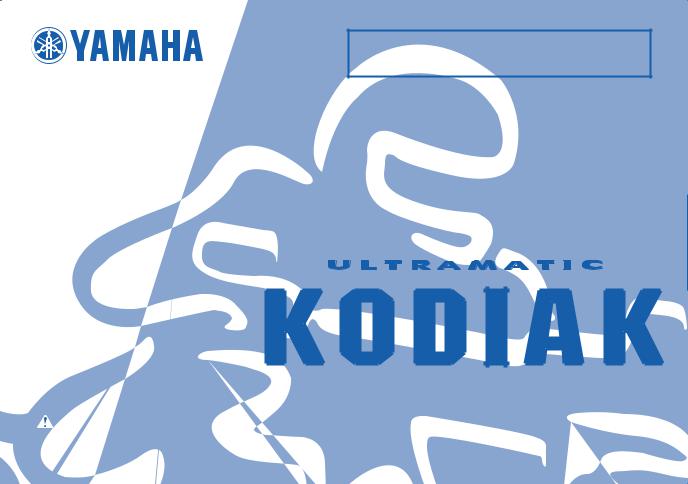
READ THIS MANUAL CAREFULLY!
It contains important safety information.
OWNER’S MANUAL
YFM400AR
WARNING |
This ATV should not be ridden by anyone under 16 years of age. |
LIT-11626-16-35 |
5VH-F8199-10 |

EBU00776
EBU00941
INTRODUCTION
Congratulations on your purchase of the Yamaha YFM400A. It represents the result of many years of Yamaha experience in the production of fine sporting, touring, and pace-setting racing machines. With the purchase of this Yamaha, you can now appreciate the high degree of craftsmanship and reliability that have made Yamaha a leader in these fields.
This manual will provide you with a good basic understanding of the features and operation of this ATV. This manual includes important safety information. It provides information about special techniques and skills necessary to ride your ATV. It also includes basic maintenance and inspection procedures. If you have any questions regarding the operation or maintenance of your ATV, please consult a Yamaha dealer.
AN IMPORTANT SAFETY MESSAGE:
●READ THIS MANUAL TOGETHER WITH TIPS FOR THE ATV RIDER CAREFULLY AND COMPLETELY BEFORE OPERATING YOUR ATV. MAKE SURE YOU UNDERSTAND ALL INSTRUCTIONS.
●PAY CLOSE ATTENTION TO THE WARNING AND CAUTION LABELS ON THE ATV.
●NEVER OPERATE AN ATV WITHOUT PROPER TRAINING OR INSTRUCTION. FREE TRAINING IS AVAILABLE TO ANYONE WHO BUYS A NEW ATV. CALL 1-800-887-2887 FOR MORE INFORMATION.
●THIS ATV, AND ANY OTHER ATV OVER 90cc, SHOULD NOT BE RIDDEN BY ANYONE UNDER 16 YEARS OF AGE.
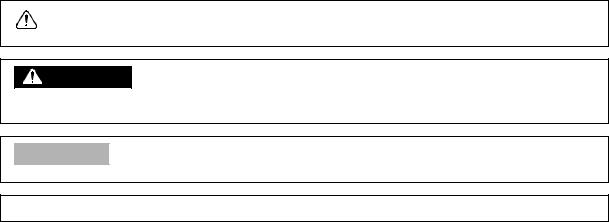
EBU00801
IMPORTANT MANUAL INFORMATION
FAILURE TO FOLLOW THE WARNINGS CONTAINED IN THIS MANUAL CAN RESULT IN SERIOUS INJURY OR DEATH.
Particularly important information is distinguished in this manual by the following notations:
The Safety Alert Symbol means ATTENTION! BECOME ALERT!
YOUR SAFETY IS INVOLVED!
WARNING |
Failure to follow WARNING instructions could result in severe |
|
injury or death to the machine operator, a bystander or a person |
||
|
||
|
inspecting or repairing the machine. |
|
CAUTION: |
A CAUTION indicates special precautions that must be taken to |
|
avoid damage to the machine. |
||
|
NOTE: A NOTE provides key information to make procedures easier or clearer.

EBU00011
IMPORTANT NOTICE
This machine is designed and manufactured for OFF-ROAD use only. It is illegal and unsafe to operate this machine on any public street, road or highway.
This machine complies with all applicable OFF-ROAD noise level and spark arrester laws and regulations in effect at the time of manufacture.
Please check your local riding laws and regulations before operating this machine.
EBU01067
AFFIX DEALER
LABEL HERE
YFM400AR
OWNER’S MANUAL
©2002 by Yamaha Motor Corporation, U.S.A.
1st edition, May 2002
All rights reserved. Any reprinting or unauthorized use without the written permission of
Yamaha Motor Corporation, U.S.A. is expressly prohibited. Printed in U.S.A.
P/N LIT-11626-16-35

EBU00014

 WARNING
WARNING
Indicates a potential hazard that could result in serious injury or death.
|
CONTENTS |
|
|
1 |
LOCATION OF THE WARNING |
|
|
AND SPECIFICATION LABELS |
1-1 |
||
|
|||
2 |
SAFETY INFORMATION.................. |
2-1 |
|
|
|
||
3 |
DESCRIPTION AND MACHINE |
|
|
IDENTIFICATION |
3-1 |
||
|
|||
|
Identification number records.......... |
3-2 |
|
|
Key identification number................ |
3-2 |
|
|
Vehicle identification number .......... |
3-3 |
|
|
Model label ...................................... |
3-3 |
4 |
CONTROL FUNCTIONS................... |
4-1 |
|
Main switch |
4-1 |
||
|
|||
|
Indicator and warning lights............. |
4-2 |
|
|
Speedometer ................................... |
4-3 |
|
|
Fuel gauge ....................................... |
4-4 |
|
|
Handlebar switches ......................... |
4-4 |
|
|
Throttle lever .................................... |
4-6 |
|
|
Speed limiter .................................... |
4-7 |
|
|
Front brake lever.............................. |
4-8 |
|
|
Rear brake pedal and lever ............. |
4-8 |
|
|
Parking brake................................... |
4-9 |
|
|
Drive select lever ........................... |
4-10 |
|
|
Recoil starter.................................. |
4-10 |
|
|
Fuel tank cap ................................. |
4-11 |
|
|
Fuel cock........................................ |
4-12 |
|
|
Starter (choke) ............................... |
4-13 |
|
|
Seat................................................ |
4-14 |
|
|
Storage box.................................... |
4-15 |
|
|
Front carrier ................................... |
4-15 |
|
|
Rear carrier .................................... |
4-15 |
|
|
Front shock absorber |
|
|
|
adjustment ................................... |
4-16 |

Rear shock absorber |
|
adjustment................................... |
4-18 |
Auxiliary DC jack........................... |
4-19 |
5 |
PRE-OPERATION CHECKS ........... |
5-1 |
|
Front and rear brakes |
5-2 |
||
|
|||
|
Fuel ................................................. |
5-4 |
|
|
Engine oil ........................................ |
5-6 |
|
|
Final gear oil.................................... |
5-7 |
|
|
Coolant............................................ |
5-7 |
|
|
Throttle lever ................................... |
5-8 |
|
|
Fittings and fasteners...................... |
5-8 |
|
|
Lights............................................... |
5-8 |
|
|
Switches.......................................... |
5-9 |
|
|
Tires ................................................ |
5-9 |
|
|
How to measure tire pressure....... |
5-11 |
|
|
Tire wear limit................................ |
5-12 |
|
6 |
OPERATION..................................... |
6-1 |
|
Starting a cold engine |
6-1 |
||
|
|||
|
Starting a warm engine................... |
6-3 |
|
|
Warming up..................................... |
6-3 |
Drive select lever operation and |
|
reverse driving ............................... |
6-4 |
Engine break-in ............................... |
6-6 |
Parking............................................. |
6-8 |
Parking on a slope........................... |
6-8 |
Accessories and loading ............... |
6-10 |
7 |
RIDING YOUR ATV .......................... |
7-1 |
|
Getting to know your ATV |
7-3 |
||
|
|||
|
Ride with care and good |
|
|
|
judgement...................................... |
7-4 |
|
|
Be careful where you ride.............. |
7-16 |
|
|
Turning your ATV .......................... |
7-22 |
|
|
Climbing uphill ............................... |
7-24 |
|
|
Riding downhill .............................. |
7-30 |
|
|
Crossing a slope............................ |
7-32 |
|
|
Crossing through shallow water .... |
7-34 |
|
|
Riding over rough terrain............... |
7-37 |
|
|
Sliding and skidding....................... |
7-38 |
|
|
What to do if................................... |
7-40 |
|
|
What to do ..................................... |
7-40 |

8 |
PERIODIC MAINTENANCE AND |
|
|
ADJUSTMENT |
8-1 |
||
|
|||
|
Owner’s manual and tool kit............ |
8-1 |
|
|
Periodic maintenance/ |
|
|
|
lubrication ...................................... |
8-3 |
|
|
Panel removal and installation ........ |
8-5 |
|
|
Engine oil....................................... |
8-12 |
|
|
Final gear oil.................................. |
8-16 |
|
|
Cooling system.............................. |
8-19 |
|
|
Changing the coolant .................... |
8-20 |
|
|
Spark plug inspection.................... |
8-24 |
|
|
Air filter element cleaning.............. |
8-27 |
|
|
V-belt cooling duct check hose ..... |
8-30 |
|
|
Spark arrester cleaning ................. |
8-31 |
|
|
Carburetor adjustment................... |
8-32 |
|
|
Idle speed adjustment ................... |
8-33 |
|
|
Valve clearance adjustment.......... |
8-33 |
|
|
Throttle lever adjustment............... |
8-34 |
|
|
Front brake pad inspection............ |
8-35 |
|
|
Rear brake shoe inspection .......... |
8-35 |
|
|
Brake fluid level check................... |
8-36 |
|
|
Brake fluid replacement................. |
8-37 |
|
|
Front brake lever free play ............ |
8-37 |
Rear brake pedal and lever |
|
adjustment ................................... |
8-39 |
Adjusting the rear brake light |
|
switch ........................................... |
8-42 |
Cable inspection and lubrication.... |
8-43 |
Lubricating the brake levers and |
|
brake pedal .................................. |
8-43 |
Wheel removal............................... |
8-44 |
Wheel installation........................... |
8-45 |
Battery............................................ |
8-46 |
Battery maintenance...................... |
8-47 |
Fuse replacement .......................... |
8-47 |
Replacing a headlight bulb ............ |
8-49 |
Headlight beam adjustment........... |
8-52 |
Tail/brake light bulb |
|
replacement ................................. |
8-52 |
Troubleshooting ............................. |
8-53 |
Troubleshooting charts .................. |
8-54 |

9 |
CLEANING AND STORAGE............ |
9-1 |
|
A. Cleaning |
9-1 |
||
|
|||
|
B. Storage ....................................... |
9-3 |
10 |
SPECIFICATIONS.......................... 10-1 |
|
|
11 |
NOISE REGULATION.................... 11-1 |
|
12 |
MAINTENANCE RECORD ............ 12-1 |
|
|
13 |
ATV LIMITED WARRANTY............ 13-1 |
|
14 |
YAMAHA EXTENDED SERVICE |
|
(Y.E.S.) ........................................... 14-1 |
||
|

EBU00464
LOCATION OF THE WARNING AND
SPECIFICATION LABELS
1-1

Read and understand all of the labels on your
machine. They contain important information 1 for safe and proper operation of your ATV.
Never remove any labels from your ATV. If a label becomes difficult to read or comes off, a replacement label is available from your Yamaha dealer.
1 |
2 |
 WARNING
WARNING
Overloading this ATV or carrying cargo improperly can change handling. stability and braking performance and can lead to an accident. Never exceed the maximum front cargo limit of
: 40kg (88 lbs)
NEVER sit on the carrier. Refer to instructions in the Owner's Manual.
5ND-F4877-00
1-2

3 |
5 |
MAXIMUM.LOADING LIMITMIT
PULLING LOAD: |
4900 |
N |
( 5 0 0 k g f ) |
|
1102 |
l b f |
|
TONGUE WEIGHT: |
147 |
N |
( 1 5 k g f ) |
|
33 |
l b f |
|
5ND-F151K-00
6
4
 WARNING
WARNING
Overloading this ATV or carrying cargo improperly can change handling. stability and braking performance and can lead to an accident. Never exceed the maximum rear cargo limit of
: 80kg (176 lbs)
NEVER sit on the carrier. Refer to instructions in the Owner's Manual.
5ND-F4897-00
1-3
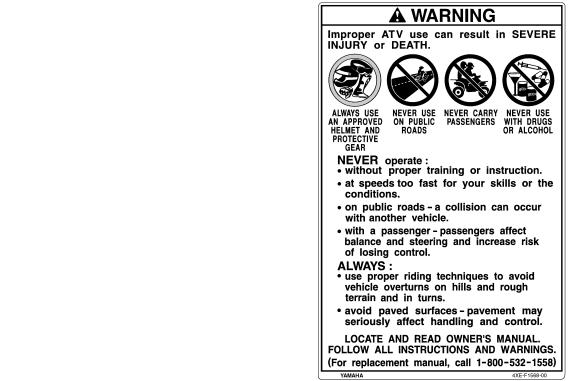
7 |
8 |
1-4

EBU01245
 SAFETY INFORMATION
SAFETY INFORMATION
AN ATV IS NOT A TOY AND CAN BE HAZARDOUS TO OPERATE. An ATV handles differently from other vehicles including motorcycles and cars. A collision or rollover can occur quickly, even during routine maneuvers such as turning and riding on hills or over obstacles, if you fail to take proper precautions.
SEVERE INJURY OR DEATH can result if you do not follow these instructions:
●Read this manual and all labels carefully and follow the operating procedures described.
●Never operate an ATV without proper training or instruction. Take a Training Course. Beginners should receive training from a certified instructor. Contact an authorized ATV dealer or call 1-800-887-2887 to find out about the training courses nearest you.
●Always follow the age recommendation:
- A child under 16 years old should never operate an ATV with engine size greater than 90 cc.
●Never allow a child under age 16 to operate an ATV without adult supervision, and never allow continued use of an ATV by a child if he or she does not have the abilities to operate it safely.
●Never carry a passenger on an ATV.
●Always avoid operating an ATV on any paved surfaces, including sidewalks, driveways, parking lots and streets.
●Never operate an ATV on any public street, road or highway, even a dirt or gravel one.
2-1

● Never operate an ATV without wearing an approved motorcycle helmet that fits properly. You |
|
should also wear eye protection (goggles or face shield), gloves, boots, long-sleeved shirt or |
|
jacket, and long pants. |
|
● Never consume alcohol or drugs before or while operating this ATV. |
2 |
●Never operate at speeds too fast for your skills or the conditions. Always go at a speed that is proper for the terrain, visibility and operating conditions, and your experience.
●Never attempt wheelies, jumps, or other stunts.
●Always inspect your ATV each time you use it to make sure it is in safe operating condition. Always follow the inspection and maintenance procedures and schedules described in this manual.
●Always keep both hands on the handlebars and both feet on the footboards of the ATV during operation.
●Always go slowly and be extra careful when operating on unfamiliar terrain. Always be alert to changing terrain conditions when operating the ATV.
●Never operate on excessively rough, slippery or loose terrain until you have learned and practiced the skills necessary to control the ATV on such terrain. Always be especially cautious on these kinds of terrain.
●Always follow proper procedures for turning as described in this manual. Practice turning at low speeds before attempting to turn at faster speeds. Do not turn at excessive speed.
●Never operate the ATV on hills too steep for the ATV or for your abilities. Practice on smaller hills before attempting larger hills.
2-2
●Always follow proper procedures for climbing hills as described in this manual. Check the terrain carefully before you start up any hill. Never climb hills with excessively slippery or loose surfaces. Shift your weight forward. Never open the throttle suddenly. Never go over the top of a hill at high speed.
●Always follow proper procedures for going down hills and for braking on hills as described in this manual. Check the terrain carefully before you start down any hill. Shift your weight backward. Never go down a hill at high speed. Avoid going down a hill at an angle that would cause the vehicle to lean sharply to one side. Go straight down the hill where possible.
●Always follow proper procedures for crossing the side of a hill as described in this manual. Avoid hills with excessively slippery or loose surfaces. Shift your weight to the uphill side of the ATV. Never attempt to turn the ATV around on any hill until you have mastered the turning technique described in this manual on level ground. Avoid crossing the side of a steep hill if possible.
●Always use proper procedures if you stall or roll backwards when climbing a hill. Maintain a steady speed when climbing a hill. If you stall or roll backwards, follow the special procedure for braking described in this manual. Dismount on the uphill side or to a side if pointed straight uphill. Turn the ATV around and remount, following the procedure described in this manual.
●Always check for obstacles before operating in a new area. Never attempt to operate over large obstacles, such as large rocks or fallen trees. Always follow proper procedures when operating over obstacles as described in this manual.
2-3
●Always be careful when skidding or sliding. Learn to safely control skidding or sliding by practicing at low speeds and on level, smooth terrain. On extremely slippery surfaces, such as ice, go slowly and be very cautious in order to reduce the chance of skidding or sliding out of control.
●Never operate an ATV in fast flowing water or in water deeper than that recommended in this manual. Remember that wet brakes may have reduced stopping ability. Test your brakes after leaving water. If necessary, apply them several times to let friction dry out the linings.
●Always be sure there are no obstacles or people behind you when you operate in reverse. When it is safe to proceed in reverse, go slowly.
●Always use the size and type tires specified in this manual.
●Always maintain proper tire pressure as described in this manual.
●Never modify an ATV through improper installation or use of accessories.
●Never exceed the stated load capacity for an ATV. Cargo should be properly distributed and securely attached. Reduce speed and follow instructions in this manual for carrying cargo or pulling a trailer. Allow greater distance for braking.
FOR MORE INFORMATION ABOUT ATV SAFETY, call the Consumer Products Safety Commission at 1-800-638-2772, or the ATV Distributor’s Safety Hotline at 1-800-852-5344.
2-4

WARNING
POTENTIAL HAZARD Improper handling of gasoline. WHAT CAN HAPPEN
Gasoline can catch fire and you could be burned.
HOW TO AVOID THE HAZARD
Always turn off the engine when refueling.
Do not refuel right after the engine has been running and is still very hot.
Do not spill gasoline on the engine or exhaust pipe/muffler when refueling. Never refuel while smoking, or while in the vicinity of sparks, open flames, or other sources of ignition such as the pilot lights of water heaters and clothes dryers.
When transporting the ATV in another vehicle, be sure it is kept upright and that the fuel cock is in the “OFF” position. Otherwise, fuel may leak out of the carburetor or fuel tank.
WHAT CAN HAPPEN
Gasoline is poisonous and can cause injuries.
HOW TO AVOID THE HAZARD
If you should swallow some gasoline or inhale a lot of gasoline vapor, or get some gasoline in your eyes, see your doctor immediately. If gasoline spills on your skin, wash with soap and water. If gasoline spills on your clothing, change your clothes.
2-5

WARNING
POTENTIAL HAZARD
Starting or running the engine in a closed area.
WHAT CAN HAPPEN
Exhaust fumes are poisonous and may cause loss of consciousness and death within a short time.
HOW TO AVOID THE HAZARD
Always operate your ATV in an area with adequate ventilation.
2-6

EBU00032
DESCRIPTION AND MACHINE IDENTIFICATION
1.Rear shock absorber assembly spring preload adjusting ring
2.Spark arrester
3.Storage box and tool kit
4.Spark plug
5.Front shock absorber assembly spring preload adjusting ring
6.Brake pedal
7.V-belt case
8.Radiator cap
9.Fuel cock
10.Air filter case
11.Fuses
12.Tail/brake light
13.Front shock absorber assembly spring preload adjusting ring
14.V-belt cooling duct check hose
15.Coolant reservoir
16.Oil filter cartridge
17.Engine oil dipstick
18.Rear brake lever
19.Left handlebar switches
20.Starter (choke)
21.Drive select lever
22.Speedometer
23.Main switch
24.Fuel tank cap
25.Auxiliary DC jack
26.Throttle lever
27.Front brake lever
NOTE:
The machine you have purchased may differ slightly from those shown in the figures of this manual.
3-1
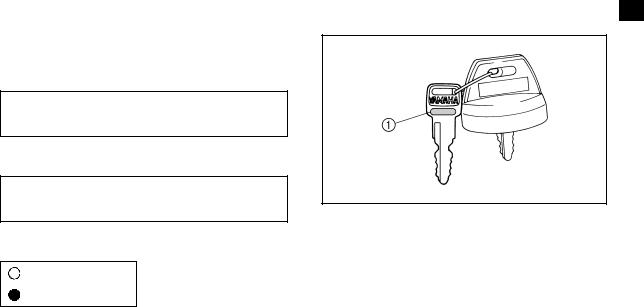
EBU00600
Identification number records
Record the key identification number, vehicle identification number and model label information in the spaces provided for assistance when ordering spare parts from a Yamaha dealer or for reference in case the vehicle is stolen.
1.KEY IDENTIFICATION NUMBER:
2.VEHICLE IDENTIFICATION NUMBER:
3.MODEL LABEL INFORMATION:
EBU00035 |
|
Key identification number |
|
The key identification number is stamped on |
|
the key as shown in the following illustration. |
|
This number can be used for ordering a new |
3 |
key. |
1. Key identification number
3-2
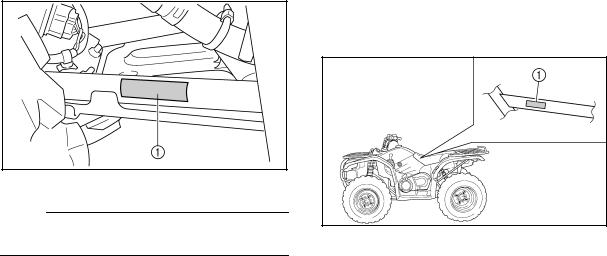
EBU00036
Vehicle identification number
The vehicle identification number is stamped into the frame.
1. Vehicle identification number (front left side)
NOTE:
The vehicle identification number is used to identify your machine.
EBU00787
Model label
The model label is affixed to the location in the illustration. Record the information on this label in the space provided. This information will be needed to order spare parts from your Yamaha dealer.
1. Model label
3-3

EBU00039
CONTROL FUNCTIONS

 WARNING
WARNING
Indicates a potential hazard that could result in serious injury or death.
4
EBU01249
Main switch
Functions of the respective switch positions
are as follows: 1. Main switch ON:
The engine can be started only at this position and the headlights, taillight and meter lighting come on when the light switch is on.
OFF:
All electrical circuits are switched off. The key can be removed in this position.
4-1

EBU00802
Indicator and warning lights
1.Coolant temperature warning light “  ”
”
2.Reverse indicator light “R”
3.Neutral indicator light “N”
EBU01223
Coolant temperature warning light “  ”
”
When the coolant temperature reaches a specified level, this light comes on to warn that the coolant temperature is too hot. If the light comes on during operation, stop the engine as soon as it is safe to do so and allow the engine to cool down for about 10 minutes. To check the coolant temperature warning light, shift the drive select lever into neutral, turn the key to “ON”, and then press the start switch. If the light does not come on, have a Yamaha dealer inspect the electrical circuit.
CAUTION:
●The engine may overheat if the ATV is overloaded. If this happens, reduce the load to specification.
●Restart after making sure that the light is out. Continuous use while the light is on may cause damage to the engine.
4-2

EBU01250
Reverse indicator light “R”
This indicator light comes on when the drive select lever is in the “R” position.
EBU00972
Neutral indicator light “N”
This indicator light comes on when the drive select lever is in the “N” position.
EBU00447
Speedometer
The speedometer shows riding speed. This speedometer is equipped with a trip odometer. The trip odometer can be reset to “0” with the reset knob. Use the trip odometer to estimate how far you can ride on a tank of fuel before going to reserve. This information will enable you to plan fuel stops in the future.
1. |
Speedometer |
2. Trip odometer |
3. |
Reset knob |
|
4-3

EBU00052
Fuel gauge
The fuel gauge indicates the amount of fuel in the fuel tank. When the needle reaches the red line, refill the tank at the first opportunity.
1. Fuel gauge |
2. Red line |
NOTE:
If the machine runs out of fuel, move the fuel cock lever to the “RES” position. Approximately 4.5 L (0.99 Imp gal, 1.19 US gal) of fuel will be remaining in the tank.
EBU00053
Handlebar switches
1.Light switch “ /
/ /OFF”
/OFF”
2.Engine stop switch “ /
/ ”
”
3.Start switch “ ”
”
EBU01251
Light switch “ /
/ /OFF”
/OFF”
Set the switch to “ ” to turn on the low beams, the taillight and the meter lighting. Set the switch to “
” to turn on the low beams, the taillight and the meter lighting. Set the switch to “  ” to turn on the high beams, the taillight and the meter lighting. Set the switch to “OFF” to turn off all the lights.
” to turn on the high beams, the taillight and the meter lighting. Set the switch to “OFF” to turn off all the lights.
4-4

CAUTION:
Do not use the headlights with the engine turned off for more than thirty minutes. The battery may discharge to the point that the starter motor will not operate properly. If this should happen, remove the battery and recharge it.
EBU01205
Engine stop switch “ /
/  ”
”
Make sure that the engine stop switch is set to “  ” before starting the engine. The engine stop switch controls ignition and can be used at all times to stop the engine, especially in an emergency. The engine will not start or run when the engine stop switch is set to “
” before starting the engine. The engine stop switch controls ignition and can be used at all times to stop the engine, especially in an emergency. The engine will not start or run when the engine stop switch is set to “ ”.
”.
EBU00607
Start switch “  ”
”
The starter motor cranks the engine when this switch is pushed.
CAUTION:
See starting instructions prior to starting the engine. (See page 6-1 for details.)
4-5

EBU00062
Throttle lever
Once the engine is running, movement of the throttle lever will increase the engine speed. Regulate the speed of the machine by varying the throttle position. Because the throttle is spring-loaded, the machine will decelerate, and the engine will return to an idle any time the hand is removed from the throttle lever.
1. Throttle lever
Before starting the engine, check the throttle to be sure it is operating smoothly. Make sure it returns to the idle position as soon as the lever is released.
WARNING
POTENTIAL HAZARD
Malfunction of throttle.
WHAT CAN HAPPEN
The throttle could be hard to operate, making it difficult to speed up or slow down when you need to. This could cause an accident.
HOW TO AVOID THE HAZARD
Check the operation of the throttle lever before you start the engine. If it does not work smoothly, check for the cause. Correct the problem before riding the ATV. Consult a Yamaha dealer if you can’t find or solve the problem yourself.
4-6

EBU01159
Speed limiter
The speed limiter keeps the throttle from fully opening, even when the throttle lever is pushed to the maximum. Turning in the adjusting screw limits the maximum engine power available and decreases the maximum speed of the ATV.
1. Locknut |
2. Adjusting screw |
WARNING
POTENTIAL HAZARD
Improper adjustment of the speed limiter and throttle.
WHAT CAN HAPPEN
The throttle cable could be damaged. Improper throttle operation could result. You could lose control, have an accident or be injured.
HOW TO AVOID THE HAZARD
Do not turn the adjusting screw out more than 12 mm (0.47 in). Always make sure the throttle lever free play is adjusted to 3–5 mm (0.12–0.20 in). See page 8-34.
4-7

EBU00070
Front brake lever
The front brake lever is located on the right handlebar. Pull it toward the handlebar to apply the front brake.
1. Front brake lever
EBU00073
Rear brake pedal and lever
The brake pedal is located on the right side of the machine and the brake lever is located on the left handlebar. Push down on the pedal or pull the lever toward the handlebar to apply the rear brake.
1. Brake pedal
1. Rear brake lever
4-8
